How to Read “curiosity killed the cat”
“Curiosity killed the cat”
[KYOOR-ee-os-ih-tee kild thuh kat]
All words use common pronunciation.
Meaning of “curiosity killed the cat”
Simply put, this proverb means that being too curious or nosy can get you into trouble.
The saying warns us about the dangers of excessive curiosity. When someone pokes around where they shouldn’t, they might discover something harmful. The “cat” represents anyone who can’t resist investigating things that might be better left alone.
We use this phrase when someone asks too many questions about private matters. It applies when people snoop through others’ belongings or dig into secrets. You might hear it at work when someone investigates office drama, or in relationships when someone reads private messages.
What’s interesting is how this wisdom balances two truths. Curiosity helps us learn and grow throughout life. But the proverb reminds us that some boundaries exist for good reasons. It teaches us to think before we investigate something that could hurt us or others.
Origin and Etymology
The exact origin of this phrase is unknown, but it first appeared in print during the late 1800s. Early versions used different wording, including “care killed the cat” in the 1500s. The word “care” meant worry or anxiety back then, not curiosity.
During the Victorian era, people valued proper behavior and respecting boundaries. This type of warning fit perfectly with social expectations of the time. Parents used such sayings to teach children about appropriate conduct and the consequences of being too bold.
The phrase gradually changed from “care” to “curiosity” as language evolved. By the early 1900s, the modern version became standard in English-speaking countries. The saying spread through literature, newspapers, and everyday conversation, becoming a common way to warn against excessive nosiness.
Interesting Facts
The original phrase “care killed the cat” appeared in Ben Jonson’s play “Every Man in His Humour” in 1598. The word “care” in old English meant anxiety, worry, or sorrow rather than looking after something. This shows how word meanings change over centuries, transforming the entire message of the proverb.
Usage Examples
- Mother to teenage daughter: “Stop asking about what’s in that locked box in the attic – curiosity killed the cat.”
- Coworker to colleague: “I wouldn’t dig into why the boss had that private meeting yesterday – curiosity killed the cat.”
Universal Wisdom
This proverb reveals a fundamental tension in human nature between our drive to explore and our need for safety. Curiosity represents one of our most powerful survival tools, helping our ancestors discover food, avoid dangers, and understand their world. Yet this same drive can lead us into situations where knowledge becomes a burden or a threat.
The wisdom recognizes that information itself can be dangerous. Some knowledge changes us permanently, creating responsibilities we didn’t want or revealing truths we can’t handle. When we learn about others’ private struggles, hidden conflicts, or painful secrets, we often wish we could return to ignorance. The proverb acknowledges that our minds naturally seek understanding, even when that understanding might hurt us.
What makes this saying endure is its recognition of curiosity’s double-edged nature. We admire curious people for their intelligence and courage, yet we also understand the risks they take. The proverb doesn’t condemn curiosity entirely but warns us to consider the consequences before we investigate. It suggests that wisdom lies not in avoiding all curiosity, but in choosing carefully what we really need to know versus what we simply want to know.
When AI Hears This
People in power use this saying to stop others from asking questions. They don’t say what dangers curiosity brings or when it becomes too much. This unclear warning works perfectly to shut down uncomfortable topics. The phrase sounds like caring advice but actually protects those who benefit from secrets.
Humans naturally create invisible barriers around forbidden knowledge using fear. Parents, teachers, and leaders deploy these warnings before anyone even asks difficult questions. This makes people stop themselves from being curious instead of being told to stop. The system works because it feels like personal choice rather than outside control.
What fascinates me is how brilliantly this backwards approach works for humans. Instead of building walls around secrets, you make people afraid to look. The warning becomes more powerful than any actual punishment could be. Humans have mastered the art of control through voluntary self-limitation using ancient wisdom.
Lessons for Today
Living with this wisdom means developing judgment about when curiosity serves us and when it might harm us. The key lies in recognizing the difference between productive curiosity that helps us grow and destructive nosiness that creates problems. Before investigating something, we can ask ourselves whether the knowledge will genuinely benefit us or others.
In relationships, this wisdom helps us respect boundaries while maintaining healthy interest in each other’s lives. Partners, friends, and family members all need some private space, even in close relationships. The proverb reminds us that trust sometimes means not looking for proof, and that some conversations happen when people are ready to share, not when we’re ready to know.
The challenge is that curiosity feels natural and often justified in the moment. We tell ourselves we need to know something for good reasons, when really we just want to satisfy our interest. The wisdom suggests developing patience and accepting that some mysteries don’t need solving. Rather than suppressing curiosity entirely, we can channel it toward areas where discovery brings genuine value. This approach honors both our natural drive to explore and our need to maintain trust and safety in our relationships and communities.



Comments